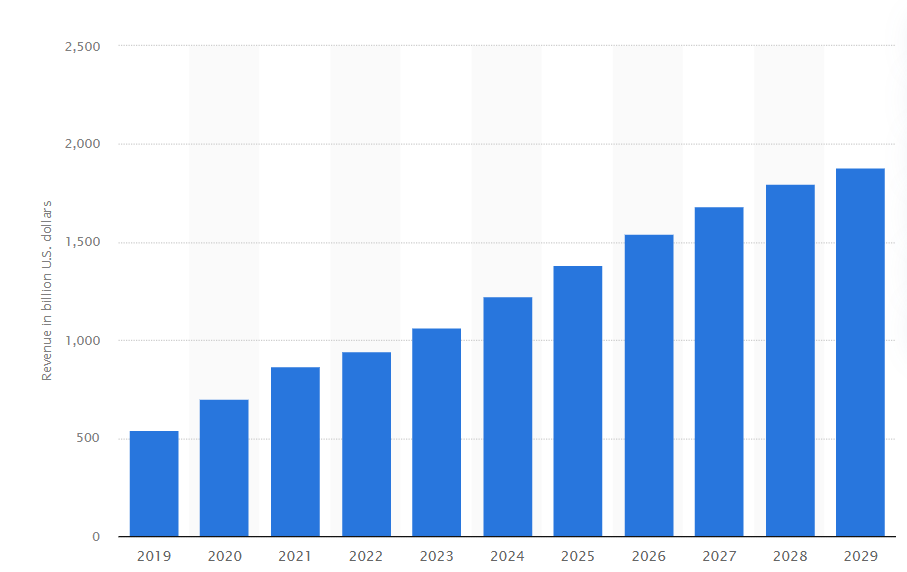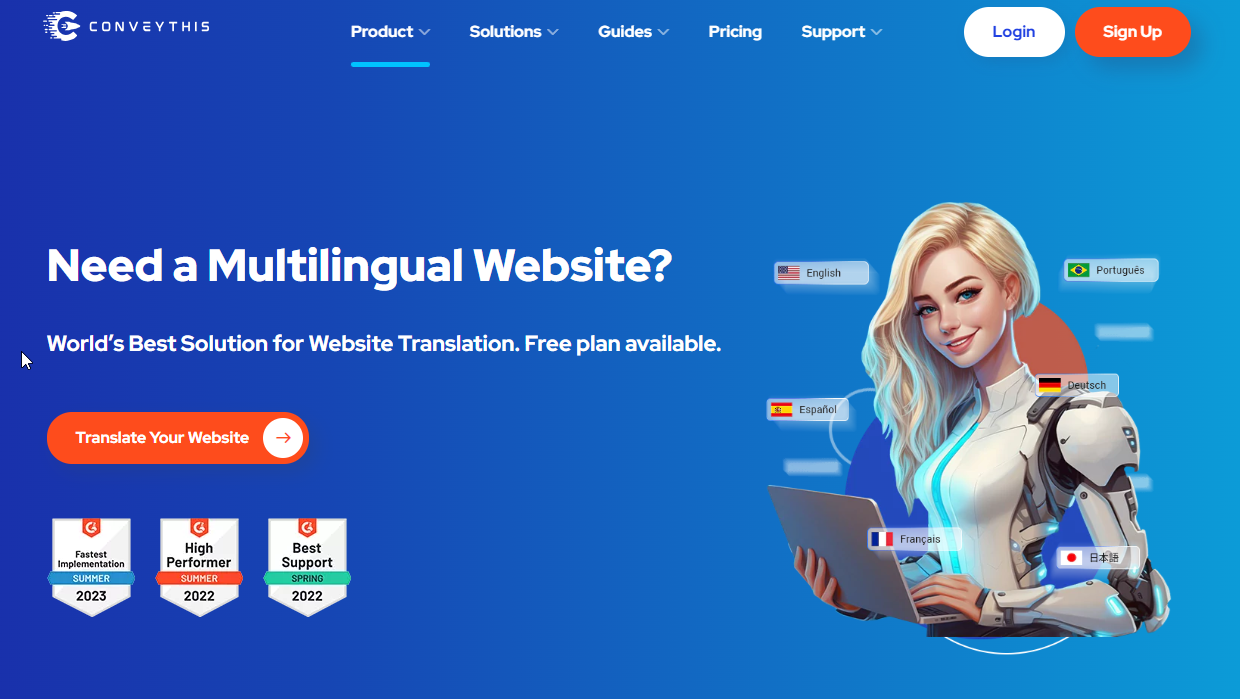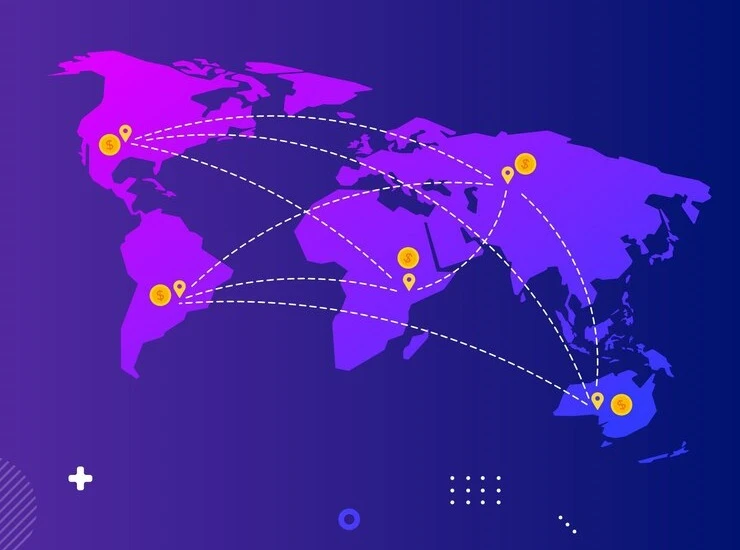スペイン語: 電子商取引の繁栄の鍵
米国はスペイン語圏で2番目に人口の多い国であることをご存知ですか? このマイルストーンは、2015年に米国のスペイン語話者の数が、スペイン語発祥の地であるスペインを上回ったことで達成されました。それ以来、米国のスペイン語話者の数は増え続け、米国はスペイン語話者の人口で世界をリードする国となっています。この点で米国を上回っているのはメキシコだけです。スペインのセルバンテス文化センターによると、米国では5000万人以上がスペイン語を話しており、どの企業も見逃すことのできない重要な人口統計となっています。増加するヒスパニック人口は、国の文化的および経済的景観を形成する強力な力を表しています。
米国のeコマースが昨年の総小売売上高の11%以上を占め[5]、5,000億ドルの市場[6]であることも考慮すると、米国のヒスパニック系コミュニティを受け入れることは大きな成長の機会となることは明らかです。スペイン語での買い物を好む消費者が多いこれらの消費者は、彼らがいる場所、つまりeコマースプラットフォームで彼らと出会う用意がある企業にとって、大きな未開拓の可能性を表しています。この人口統計を無視することは、機会を逃すだけでなく、競争が激化する市場で大きな不利になります。特にデジタル空間で彼らの言語の好みに応えることは、ロイヤルティを構築し、売上を増やす確実な方法です。

しかし、明らかな市場機会があるにもかかわらず、明らかなギャップがあります。米国の電子商取引ウェブサイトのうち、多言語対応しているのはわずか 2.45% で、米国を拠点とする電子商取引サイトの 95% 以上が英語のみで利用できることを意味します。スペイン語圏のユーザーをめぐる競争はまだ比較的限られているため、バイリンガル化に前向きな企業にとっては大きなチャンスとなります。多言語サイトのわずかな割合のうち、スペイン語版を提供しているのは 5 分の 1 未満であり、ブランドがこの大規模で増加している人口層に対応できる大きな余地が残されています。
この市場のギャップは、一部の先進的な企業だけがヒスパニック系消費者層の潜在力を認識しているという事実を浮き彫りにしています。これらの早期導入企業は、バイリンガル電子商取引のリーダーとしての地位を確立し、スペイン語を話す顧客にうまくリーチして、この十分にサービスされていない市場のメリットを享受しています。これらの企業は、ウェブサイトのスペイン語版を提供することで競争上の優位性を獲得し、忠実で拡大する顧客層を獲得しています。
今こそ、このチャンスを活かす絶好のタイミングです。eコマース サイトのスペイン語版を提供することで、米国に住む 5,000 万人のネイティブ スペイン語話者と、さらに多数のバイリンガル スペイン語話者を引き付けることができます。これにより、市場へのリーチが拡大するだけでなく、これまでほとんどの企業が実現できなかった方法で、売上、ブランド ロイヤルティ、顧客満足度が向上します。米国のスペイン語市場は成長を続けており、eコマース企業がこの市場を活用できる可能性はかつてないほど高まっています。この広大で貴重なオーディエンスを競合他社に奪われないように、今すぐ彼らの言語で話し始めましょう。
バイリンガルサイトになる方法: 多言語ウェブサイトの力を引き出す
米国は歴史的に、多言語ウェブサイトの作成と設計において世界の多くの国に遅れをとってきました。英語は長い間他の言語よりも優先されてきましたが、そのせいで広範かつ貴重な消費者基盤の取り込みが犠牲になることも少なくありませんでした。この見落としは、特に米国の言語環境が多様であることを考えると、経済成長の機会を逃すことを意味します。
英語のみのウェブサイトに限定している企業は、利益を逃しています。米国では英語圏のユーザー獲得競争が激しく、無数の e コマース サイトが注目を集めようと競い合っています。しかし、ウェブサイトにスペイン語版を追加すると、状況は劇的に変わります。スペイン語圏のユーザーは米国で急速に成長している市場セグメントであり、彼らの言語の好みに合わせたコンテンツに対する需要が高いです。このバイリンガル ユーザー層に対応することで、企業は競争上の優位性を獲得し、十分にサービスを受けていないが強力な消費者層に参入することができます。
とはいえ、バイリンガル ユーザー ベースを引き付けるのは、Web サイトのコンテンツを Google 翻訳に貼り付けて終わりというほど簡単ではありません。自動翻訳では、文脈、語調、文化的なニュアンスが失われることが多く、ユーザー エクスペリエンスが低下して潜在的な顧客を遠ざけてしまう可能性があります。バイリンガル戦略を成功させるには、メッセージが両方の言語で同じように伝わるように、綿密な計画、専門的な翻訳、文化的適応が必要です。
幸いなことに、あなたは今、効果的な多言語戦略を作成する方法を学ぶのにぴったりの場所にいます。この記事では、真にバイリンガルな e コマース サイトを構築する手順を説明します。しかし、「方法」に入る前に、ストアをスペイン語で利用できるようにすることがビジネスにとって賢明な選択である理由をさらに探ってみましょう。
公共の場では英語を話し、ブラウジングはスペイン語で:バイリンガルのアメリカ人流
アメリカのスペイン語ネイティブスピーカーはバイリンガルの技をマスターしています。学校、職場、その他の公共の場では英語で流暢にコミュニケーションをとることが多い一方で、私生活や個人的な習慣はスペイン語に傾いています。この 2 言語ライフスタイルは、彼らの文化的伝統との深いつながりを反映しており、言語が状況に応じて異なる役割を果たすことができることを示しています。
彼らのデジタル嗜好を詳しく見てみると、興味深い習慣がいくつかあることが分かります。多くのヒスパニック系アメリカ人は、携帯電話、タブレット、ノートパソコンなどのデバイスをスペイン語に設定し、アプリのインターフェースからシステム コマンドまですべてが母国語と一致するようにしています。彼らのキーボードには象徴的な ñ が表示されることが多く、Alexa や Siri などの AI アシスタントもスペイン語で道順やリマインダー、回答を提供します。この嗜好は、スペイン語がコミュニケーション手段としてだけでなく、彼らのアイデンティティの不可欠な部分として重要であることを浮き彫りにしています。
さらに、バイリンガル検索者は、独特のオンライン行動を示します。Googleによると、彼らは検索のコンテキストや探しているコンテンツの種類に応じて、英語とスペイン語を交互に使用します。ニュース記事を読む、オンラインショッピングをする、ビデオを見るなど、この2言語アプローチにより、バイリンガルは米国のオンラインメディア消費の30%以上を占めるダイナミックな視聴者として位置付けられています[7]。
企業にとって、この洞察は、デジタルプレゼンスにバイリンガルまたはマルチリンガルのアプローチを採用する必要性を強調しています。スペイン語でコンテンツとインターフェースを提供することで、企業はこの増加している人口層と効果的に関わり、文化的に多様でテクノロジーに精通したオーディエンスとのより強いつながりを育むことができます。
スペイン語は電子商取引の繁栄の鍵となるのでしょうか?
1. スペイン語SEOに投資する
ここで重要な点があります。Google などの検索エンジンは、ブラウザやデバイスが設定されている言語を認識しており、その言語で検索結果を優先的に表示します。たとえば、携帯電話が英語に設定されている場合、フランス語や日本語の Web サイトにつながる検索結果が上位に表示される可能性は低くなります。同じルールがスペイン語話者にも当てはまり、検索結果はスペイン語のサイトに合わせて調整されます。
つまり、スペイン語でウェブサイトを利用できることは、単にあればよいというだけでなく、競争上必須のことです。スペイン語に設定されたデバイスで実行される検索では、スペイン語のサイトは英語のみのサイトよりも優先されます。米国に拠点を置いていて、スペイン語でサイトを提供していない場合は、この十分にサービスされていないユーザー層をすでに獲得している競合他社に囲まれ、不利な立場に陥ります。
良いニュースは、スペイン語を話す人々は未開拓の消費者層であり、サイトをバイリンガルにする時期が早ければ早いほど、その見返りは大きくなるということです。しかし、サイトのスペイン語版を作成することは、最初のステップにすぎません。その効果を最大限に高めるには、スペイン語の SEO を最適化する必要があります。ConveyThis のようなツールは、検索エンジンがサイトをスペイン語の関連性の高い高品質のリソースとして認識するのに役立ちます。
覚えておいてください: サイトのスペイン語版がどんなに視覚的に魅力的でも、ターゲット ユーザーが見つけられなければ効果はありません。スペイン語の SEO により、サイトが適切な検索結果に表示されるようになり、新しいユーザー層とつながることができます。
2. スペイン語のメトリクスを解読する
サイトのスペイン語版を公開することは重要なマイルストーンですが、そのパフォーマンスを追跡することも同様に重要です。スペイン語のコンテンツがユーザーをどの程度引き付けているか、またこれらの訪問者がどのようにしてオンラインでサイトを見つけているかを分析する必要があります。
Google アナリティクスは、オーディエンスに関する洞察を収集するための貴重なツールです。サイト訪問者が使用している言語バージョンや、検索エンジン、バックリンク、直接ナビゲーションなど、サイトにどのように到達したかを表示できます。これらのパターンを理解することで、データに基づいた意思決定を行い、戦略を洗練させてさらに大きな成功を収めることができます。
これらの分析情報にアクセスするには、Google アナリティクスの「地域」タブの「言語」セクションに移動します。これにより、オーディエンスの言語の好みや行動に関する詳細なデータが提供されます。また、Google アナリティクス内の人口統計データやトラフィックソースなどの他の機能を調べて、バイリンガル戦略をさらに最適化することもできます[8]。
スペイン語の指標を常に把握しておくことで、何が効果的で、何を調整する必要があるかを特定できます。これにより、推測に頼るのではなく、視聴者がコンテンツとどのようにやり取りしているかの具体的な証拠に基づいて決定を下すことができます。
多文化コンテンツの作成: 視聴者の心に訴える
どの言語にも文化、歴史、ニュアンスがあり、バイリンガルの人はそれぞれの言語に浸りながら成長します。つまり、文法、スラング、伝統、価値観が 2 倍になります。これらの要素の中には矛盾しているように見えるものもありますが、バイリンガルの人は独自の方法でそれらを調和させ、二重の言語的、文化的アイデンティティを誇りと安らぎの源に変えています。
多文化コンテンツを作成する場合、これらの複雑さを理解することが重要です。公共広告を配信する場合でも、マーケティング キャンペーンを作成する場合でも、言語と文化へのアプローチ方法によって、メッセージの成否が決まります。
公共サービス キャンペーンでは、直接翻訳と一貫したフォーマットで十分な場合が多くあります。目標は、明確で率直なコミュニケーションです。たとえば、ニューヨーク市は略奪的貸付に対抗するための広告を、ほぼ同一の英語版とスペイン語版で発表しました。このようなキャンペーンは、明快さと普遍性によって成功します。

出典: https://www1.nyc.gov/site/dca/media/combat-predatory-lending.page
製品を売る:適応の芸術
バイリンガルやスペイン語圏の顧客への製品マーケティングは、はるかに微妙な問題です。ヒスパニック系アメリカ人の消費者と効果的につながるには、企業は翻訳を超えて、文化的な適応を取り入れる必要があります。その方法は次のとおりです。
既存のキャンペーンの適応:
- 視覚的要素:視聴者の文化的共感を呼ぶカラーパレット、画像、モデルを検討します。
- メッセージ:スローガンやキャッチフレーズは、ヒスパニック文化にとって非常に重要な家族、伝統、コミュニティなどの価値観を反映するように作り直す必要があるかもしれません。
限定キャンペーンの作成:
より効果的なアプローチは、スペイン語圏の視聴者に特化したキャンペーンを展開することです。たとえば、Payless ShoeSource は、ヒスパニック系の顧客専用にデザインされた広告を作成することで大きな成功を収めました。これらの広告は、スペイン語圏の視聴者に人気のチャンネル (スペイン語の TV ネットワークなど) で放映され、リーチとエンゲージメントが最大化されました。
カスタマイズされたキャンペーンが成功する理由
データもこれを裏付けています。ComScore の調査によると、スペイン語圏のユーザー向けに特別に設計されたキャンペーンは、一貫して優れたパフォーマンスを発揮します。
- 英語からスペイン語に適応したキャンペーン
- テキストまたは音声のみが翻訳されたキャンペーン
調査により、スペイン語圏の視聴者は、自分たちの文化的背景を考慮して作成された広告を強く好むことが明らかになりました。これは、適応されたキャンペーンは効果的である可能性があるものの、オリジナルのスペイン語キャンペーンの方がより深いレベルで共感を呼ぶことを示唆しています。
文化的関連性が鍵
英語圏の経験や価値観を反映したコンテンツを作成することは、スペイン語圏の視聴者とつながるための最も難しい方法です。たとえば、個人主義や自給自足を強調する広告は、家族、コミュニティ、共有体験の重要性など、ヒスパニック系の中核的な価値観と矛盾するため、効果がない可能性があります。
Think With Google のレポートでは、食べ物、伝統、休日、家族の絆など、ヒスパニック系の人々にとって重要な文化的要素が特定されています。これらのテーマをキャンペーンに取り入れることで、オーディエンスとの感情的なつながりを育むことができます。
目的に共鳴する
企業にとって、コンテンツを適応させることは、ヒスパニック系アメリカ人の消費者を引き付けるための最低限の要件です。彼らの関心と忠誠心を本当に獲得するには、キャンペーンを最初から彼らの文化と価値観に合わせて調整する必要があります。つまり、彼らの独自のアイデンティティと優先事項を反映したスペイン語市場固有の戦略を採用するということです。
多文化マーケティングは、適切に実行すれば、単に翻訳するだけでなく、超越し、ブランドがオーディエンスとの真のつながりを築き、長続きする関係を築くことを可能にします。
最適な広告配置の選択: リーチの最大化
米国のスペイン語圏の人々にリーチするには、ラジオ局やテレビチャンネルなどの従来のプラットフォームから、デジタル広告が提供する広範な機会まで、さまざまなオプションがあります。ただし、ComScore の調査結果によると、オンライン広告はエンゲージメントの最も効果的な手段であり、テレビやラジオなどの従来の媒体よりも大きな効果をもたらします。
オンライン広告が優れている理由
オンライン広告には明確な利点があります。
- ターゲットを絞ったリーチ:デジタル プラットフォームを使用すると、広告主は言語の好みなど、特定の人口統計をターゲットにできるため、スペイン語を話す視聴者とのつながりが容易になります。
- インタラクティブなエンゲージメント:従来の広告とは異なり、オンライン広告は、Web サイトへのアクセス、サービスへの登録、購入などの即時のアクションを促進できます。
-
柔軟性:キャンペーンは、パフォーマンス メトリックに基づいて、リアルタイムで簡単に変更または最適化できます。
モバイル向けに最適化: ユーザーがどこにいても対応
ヒスパニック系アメリカ人は熱心なモバイル ユーザーです。ショッピング、ソーシャル メディアの閲覧、地元のビジネスの検索など、彼らはスマートフォンに大きく依存しています。彼らの注意を効果的に引き付けるには、次のことを行います。
- レスポンシブ デザインを使用して、Web サイトがモバイル フレンドリーであることを確認します。
- デジタル タッチポイント (広告、ランディング ページ、チェックアウト プロセス) を最適化して、モバイル デバイスですばやく読み込まれ、正しく表示されるようにします。
- ユーザーの行動に合わせて、Facebook のカルーセル広告や、Instagram や TikTok などのプラットフォームの縦型動画広告など、モバイル固有の広告フォーマットを実装します。
- スペイン語ウェブコンテンツの大きな可能性
BuiltWith.comによると、スペイン語で利用できる米国ベースのウェブサイトはわずか120万件です。これはかなりの数のように聞こえるかもしれませんが、米国のすべてのサイトドメインのわずか1%に相当します。対照的に、スペイン語は米国で2番目に広く話されている言語であり、何百万人もの話者がeコマース市場に大きく貢献しています[10]。
この格差は絶好の機会をもたらします。
- スペイン語を話す何百万人もの人々が、スペイン語に設定されたデバイスを積極的に使用していますが、彼らの言語設定に対応している Web サイトはごくわずかです。
- スペイン語のコンテンツを作成する努力をする企業は、このギャップを埋めることができ、この増加する人口統計を無視する競合他社よりも目立つことができます。
多言語広告戦略の最適化
スペイン語の SEO を戦略に加えると、基本的な分析情報を収集するだけでなく、スペイン語を話すユーザーに対してビジネスを成功に導くことができます。これらの洞察により、スペイン語を話すユーザーがオンライン コンテンツとどのようにやり取りするか、どこで閲覧する可能性が最も高いか、どのキーワードがユーザーをサイトに誘導するかについて、より深く理解できます。しかし、この貴重なデータを効果的に使用するにはどうすればよいでしょうか。
トランスクリエーション:逐語訳を超えて
スペイン語圏の顧客の心に響くためには、単なる翻訳以上のものが必要です。そこでトランスクリエーション、つまりコンテンツを言語だけでなく文化にも適応させるプロセスが必要になります。ネイティブ スピーカーはトランスクリエーションで重要な役割を果たし、元の広告の核となるメッセージは維持しつつ、フレーズ、イディオム、文化的参照を調整してスペイン語圏の視聴者にとってより関連性のあるものにします。
- 文化的感受性:トランスクリエーションには、文化の違いに対する微妙な理解が必要です。たとえば、ユーモア、スラング、視覚的なヒントは、ある市場では効果があっても、別の市場では効果がなかったり、逆効果になったりすることがあります。この慎重なバランス調整により、スペイン語でも英語と同じように広告に感情的なインパクトと効果を与えることができます。
- 直訳の落とし穴を避ける:前述のように、逐語訳に頼ると、視聴者に支離滅裂でぎこちない印象を与える可能性があります。翻訳が下手だとメッセージが薄れ、不自然で魅力のないものに感じられる可能性があります。トランスクリエーションにより、広告の意図を維持しながら、ターゲット言語で広告が自然に流れるようになります。
キャンペーンを適応させるためのこの思慮深いアプローチには時間と専門知識が必要ですが、多言語広告のパフォーマンスを高めるには不可欠です。結局のところ、目標はコミュニケーションをとることではなく、オーディエンスを惹きつけ、コンバージョンさせることです。
多言語ウェブサイトに配慮する
魅力的な多言語広告キャンペーンでオーディエンスの注目を集めたら、トップクラスの Web サイト エクスペリエンスでその勢いを維持する必要があります。サイトは、広告キャンペーンが醸し出すのと同じレベルのコミットメントとプロフェッショナリズムを反映する必要があります。Web サイトが本当に多言語対応であることを確認する方法は次のとおりです。
品質の高いデザインとユーザーエクスペリエンスを優先する:
- シームレスなブラウジング エクスペリエンス:スペイン語圏のユーザーにとって、ブラウジング エクスペリエンスはスムーズで直感的、そして快適なものでなければなりません。明確なナビゲーションと好みに合ったデザイン要素により、訪問者は安心感を抱く必要があります。
- 多言語の一貫性:ホームページからチェックアウト ページまで、デザインはすべての言語でエレガントで使いやすいものでなければなりません。サイトの美観を損なうことなく、ボタン、フォーム、リンクなどのすべてのインタラクティブ要素がスペイン語でも利用できるようにしてください。
これは、コンテンツを翻訳するだけでなく、サイトのレイアウトが複数の言語でどのように機能するかを考慮することも意味します。たとえば、スペイン語は英語よりも冗長なことが多いため、長いフレーズに対応するためにボタンのサイズ、テキスト ボックス、または見出しを調整する必要がある場合があります。
グローバルウェブサイトデザイン: 多言語ニーズに合わせたレイアウトのカスタマイズ
世界中で利用されるウェブサイト、特にスペイン語のような言語でウェブサイトを設計するには、適応性が求められます。スペイン語のフレーズや文章は英語のものよりも長くなる傾向があるため、レイアウトを調整する必要があるかもしれません。サイトに関する考慮事項をいくつかご紹介します。
- 柔軟なレイアウト:ウェブサイトのレイアウトがテキストの拡張に対応できるほど柔軟であることを確認してください。たとえば、ボタンやナビゲーション バーには、長いスペイン語のテキストを収めるためにより多くのスペースが必要になる場合があります。
- モジュールと画像:画像、アイコン、モジュールなどの特定の視覚要素を、翻訳されたコンテンツに適合するように微調整する必要がある可能性があります。画像が文化的に適切であり、伝えたいメッセージと一致していることを確認してください。
- ローカライズされたユーザー エクスペリエンス:サイトのアーキテクチャは、スペイン語を話すユーザーの好みやニーズも反映する必要があります。たとえば、スペイン語を話す国の中には、左から右へのナビゲーションを好む国もあれば、特定の地域の好みに合わせて調整が必要な国もあります。
サイトの構築に使用するプラットフォームでは通常、こうした調整をより簡単に行うためのツールがいくつか提供されますが、多言語戦略ではユーザー エクスペリエンスを最優先に考える必要があります。
ユーザーのように考える
重要なのは、オーディエンスに訴えかけるウェブサイトを作成することです。言葉を翻訳するだけではなく、ユーザーを念頭に置いてエクスペリエンスを設計してください。インタラクティブなフォームからポップアップ メッセージやビデオまで、サイトのすべての要素は、スペイン語を話すユーザーのユーザー エクスペリエンスを向上させるように設計する必要があります。
エクスペリエンスを最適化するための手順は次のとおりです。
- ローカライズされたコンテンツ:ビデオ、お客様の声、ブログには、現地のスペイン語の方言や文化的参照が反映されている必要があります。
- カスタマイズされたフォーム:あらゆるフォーム (サインアップ フォームやお問い合わせフォームなど) がスペイン語で簡単に入力でき、スペイン語を話す顧客にとって適切な言語とフィールドを備えていることを確認します。
- ポップアップとアラート:シンコ・デ・マヨや死者の日などの祝日のプロモーションなど、文化的に意味のあるスペイン語のポップアップやアラートをデザインします。
プロの翻訳でコミュニケーションギャップを埋める
多言語サイトを作成するためにスペイン語に堪能である必要はありませんが、翻訳に関しては専門家の助けが不可欠です。ConveyThis のようなプロの翻訳サービスと連携することで、コンテンツが正確に翻訳され、文化的に関連性のあるものになります。ConveyThis のようなツールを使用すると、ウェブサイトのスペイン語バージョンは、元の英語バージョンと同じくらい魅力的で、魅力的で、機能的になります。
- ブランド アイデンティティの損失なし:新しい言語に展開する際の最大の懸念の 1 つは、ブランド アイデンティティの損失です。ただし、プロの翻訳サービスでは、ブランドのトーンと個性が確実に伝わり、すべての言語バージョンで一貫性が保たれます。
-
定期的な更新: ConveyThis は、元のコンテンツが進化してもウェブサイトが最新の状態を保つよう、一貫した更新を提供します。これにより、すべての翻訳がマーケティング目標に沿ったものになります。
スタイリッシュにバイリンガル市場を制覇
サイトがホストされているプラットフォームに関係なく、ConveyThis は、Web サイトがスペイン語に翻訳されるだけでなく、スペイン語の SEO 向けに最適化されることを保証します。定期的に更新されるコンテンツを統合し、トップレベルの SEO プラクティスを維持することで、スペイン語の検索エンジンでサイトの可視性を高めます。
新しい多言語サイトは、米国だけで 1.5 兆ドルの購買力を持つバイリンガル市場への扉を開きます。多言語 e コマースへのこの一歩を踏み出すことで、未開拓の可能性に満ちた市場に参入できます。ConveyThis を使用すると、バイリンガル市場への拡大はエキサイティングでシームレスな旅になります。
結論:
米国にはスペイン語を話す人口が数多くおり、購買力は大きく、オンラインでも存在感を示しています。しかし、米国の e コマース ウェブサイトのほとんどはスペイン語のオプションを提供しておらず、大きな未開拓市場が残されています。この見落としは、企業が潜在顧客を逃しているだけでなく、急速に成長し、デジタルに積極的に関与する人口層のニーズを無視していることを意味します。米国のスペイン語話者は、多様な伝統と価値観を持つ文化的な大国であり、彼らの母国語で直接語りかけることができるブランドにとって、非常に貴重なオーディエンスとなります。
スペイン語版のウェブサイトから始めて、eコマース戦略にバイリンガルを取り入れることで、文化的に豊かでデジタルに積極的なユーザー層とつながるユニークな機会が得られます。成長の可能性は大きく、ヒスパニック系アメリカ人の購買力は 1.5 兆ドルを超え、米国最大の消費者グループの 1 つとなっています。このユーザー層を優先することで、リーチを拡大するだけでなく、パーソナライズされた包括的なやり取りを重視するコミュニティ内での忠誠心を高めることにもなります。
この市場にうまく参入するには、単なる翻訳以上のことが不可欠です。文化的なニュアンスを考慮したプロの翻訳サービス (トランスクリエーションなど) を取り入れ、マーケティング キャンペーンを調整し、ユーザー フレンドリーで文化的に共鳴する Web サイトを設計することで、ヒスパニック系アメリカ人に直接語りかける没入型のオンライン エクスペリエンスを作成できます。彼らの言語を話すだけでなく、彼らの価値観、伝統、ニーズを理解することが信頼を築き、長期的な関係を育むことにつながります。
ConveyThis は、言語のギャップをシームレスに埋め、この収益性の高い市場でビジネスを成功に導きます。既存の Web サイトと統合するように設計されたソリューションを使用すると、コンテンツを簡単に翻訳し、スペイン語の SEO を最適化し、スペイン語を話す訪問者に一貫性のある魅力的なエクスペリエンスを提供できます。顧客ベースの拡大を目指す小規模ビジネスでも、より包括的なオンライン プレゼンスの構築を目指す大規模ブランドでも、ConveyThis は、メッセージが適切な方法で適切な対象者に届くようにするのに役立ちます。
追加リソース:
- ConveyThis 統合 – WordPress との互換性を調査します。
- WordPress を翻訳する方法– 詳しいガイダンス。
- WordPress ウェブサイトを翻訳するためのヘルプ ガイド– ステップバイステップのサポート。
- ガーディアン– 米国はスペイン語圏で2番目に人口の多い国。
- Statista – 小売売上高に占める電子商取引のシェア – 米国の電子商取引と小売売上高に関する統計。
- Statista – 米国小売電子商取引売上予測 – 米国における電子商取引の成長予測
- Wordstream – AdWords での言語ターゲティングに関する洞察。
- Neil Patel のブログ– Google アナリティクスを効果的に使用するためのガイド。
- Think With Google – オンラインでデジタルヒスパニックとつながるための調査。
- Registrar Owl – 国別のドメインレポート。
翻訳は、単に言語を理解するだけではなく、複雑なプロセスです。
私たちのヒントに従い、ConveyThis を使用すると、翻訳されたページはターゲット言語のネイティブのように読者に伝わり、共感を呼ぶでしょう。
労力はかかりますが、結果は報われます。Web サイトを翻訳する場合、ConveyThis の自動機械翻訳を使用すると、何時間も節約できます。
ConveyThis を 7 日間無料でお試しください!




